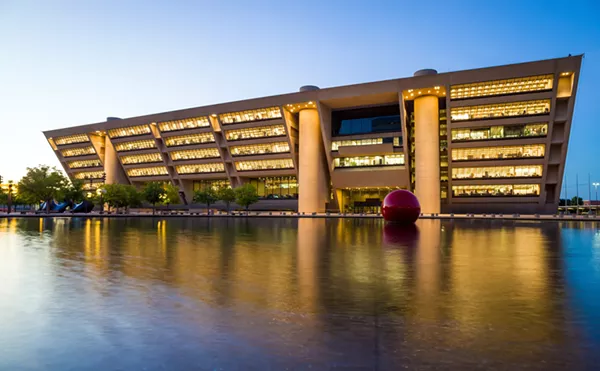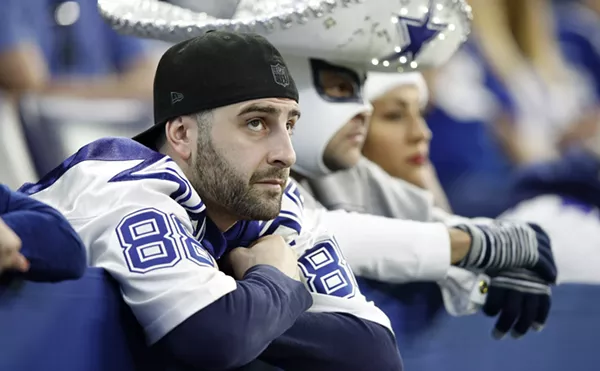There was a day when the three men who sat in front of me in the Dallas City Council chamber for Monday's Trinity toll road meeting could have said jump, and the entire Dallas City Council would have fainted from embarrassment for not having thought of it themselves. But this is a new day and not a good one for them.
Look at them: Jere Thompson Jr., sleek and patrician, heir to the 7-Eleven fortune, founder of Ambit Energy (electricity); Lee Jackson, gray but unbent, chancellor of the University of North Texas System and former longtime Dallas County judge; Ron Kirk, man from the mountaintop, former Dallas mayor but more recently Obama's global trade ambassador.
Who would dare toss eggs in the face of these guys? Judging by Monday, I’d say everybody. Didn't used to be that way.
They are here to present the final report of a special mayoral citizens advisory committee on the toll road project. Yes, you are right, this is a story you have heard already at least a thousand times. Sorry. They keep bringing it back from the grave.
Last year just before citywide elections for mayor and the council, the mayor and some philanthropists hired a “dream team” of paid consultants to come to town and say that the proposed highway along the river would not conflict with plans for a park.
That dream team came up with drawings of a beautiful meandering little country lane along the river. They said that was what the highway would look like. But critics of the project said the pastels were possibly stupid and a fraud.
So the mayor and Dallas City Council member Sandy Greyson appointed three people each to a citizens advisory committee, the one there Monday, to review the dream team’s pastel renderings.
The three august personages I mentioned above were the mayor’s appointments. They all have long histories as ardent supporters of the still unbuilt highway along the river.
But also on that committee were Greyson’s appointees: state Representative Rafael Anchia, Dallas architect Robert Meckfessell and former City Council member, Angela Hunt, all of whom, especially Hunt, have been outspoken critics of the road. They believe that a big, fat, honking, exhaust-spewing freeway would spoil chances for a major urban park along the river and also would fail monumentally as a traffic congestion reliever.
Thompson, the 7-Eleven guy, tried to put a brave face on things first by telling the assembled council members that pretty much the whole Citizens Advisory Committee, except Hunt, of course, agrees that the dream team pastel drawings were great and we should stop worrying and just get on with it with maybe a few tweaks.
From there, it fell apart, pretty much immediately.
Anchia spoke: “For those of you who expect a low-speed meandering park access road, you are going to be sorely disappointed.”
His side of the table, the three highway skeptics, agreed they didn’t want to oppose the thing just to oppose it. “We tried to be self-critical and open-minded [about] whether or not we were being too harsh in our assessment of this vision.” So they talked to some independent transportation experts.
They told the experts they were worried. On the actual engineering plans — not the lovely pastels from the hired lotus-eaters but the boring old blueprints — the road seemed awfully big and fat and highway-like.
Anchia told the council, “The experts said, ‘Well, trust yourselves. If it looks like a highway and it feels like a highway, then it’s a highway.’”
Then Anchia talked about how that could happen. He used a favorite phrase of the consultants, who kept saying last year, “The park must be the client.” He kind of tossed that back at them:
“If the park is the client, how can a group of experts like the dream team decide on a highway running through it?” Anchia asked.
I was on the edge of my seat, because I wanted to hear him say it. He said, “That’s because the task of the dream team was to make the highway fit the park.”
Yeah, OK, let me interject something here. Anchia is a smart successful attorney who knows how to say things smoothly and diplomatically. I am none of those things, so this is how I would say the same thing:
They did what they were paid to do. A group of rich people hired a bunch of I-will-work-for-a-big-fat-fee consultants to come to town, stay in hotels and produce pastel pictures to show that a highway is not a highway. Pay me one-tenth what they got, I can write something up for you saying that a rose is not a rose.
So, next, came Hunt herself to explain what it was in those blueprints that made her side of the table so suspicious. Her wheelhouse has always been parking herself at her kitchen table all weekend with stacks of files 2 feet deep and digging down to all the stuff that everybody always assumes nobody will ever dig down to.
So she did dig, and she did find it. This is all about speed limits. The Thompson/Jackson/Kirk half of the advisory committee is saying the road is designed for 45 mph speed limits.
Hunt told the council members: “What we found was that the road appears to be designed for much higher speeds. The curves on the road are twice, some of them four times bigger than the curves on a road that was actually designed for 45 miles per hour. The acceleration lanes out of the parking areas are, some of them, three football fields long.”
Get it? They build it to the dimensions of a freeway on the ground, but at first they stripe it to look like a little meandering lane. Later they can add whatever pavement is needed to blow it out to a full-size expressway.
If it can be made to accommodate faster speeds, she said, there will be immediate pressure from impatient cut-through suburban commuters to do just that. She cited an ongoing case in Fort Worth where neighborhoods were promised a meandering slow road. It opened just a few years ago. Now already the city is negotiating with the state to jack up the speeds.
She said now is the moment — right now — to stop this thing in its tracks, pin it down cold and see what it is really. If it is allowed to metastasize another two years as the other three are urging, the project will rack up more millions of dollars in design and engineering costs and be that much harder politically to rein in.
OK, that’s the nice part of the meeting, where everybody was still pretty much taking it easy on the three august personages and their report on the pastels. But then the City Council members began to weigh in.
First, Oak Cliff council member Scott Griggs pointed to a claim in the advisory committee’s official report which he more or less said had to be a lie. It’s a claim that building the little meandering pastel road will slash congestion on the existing freeways by 25 to 35 percent — far above anything anybody has ever claimed before even if it’s a full-bore expressway.
Griggs asked Mark McDaniel, the assistant city manager in charge of the data, if he had that data. The answer was no. Not on him.
Then Griggs unleashed: “In the past no project has had as much secrecy and duplicity as this project, the Trinity tollway. It continues to be a high-speed tollway through the park.
“I am extremely concerned that this boondoggle continues. I am also extremely concerned about the lack of transparency. It’s completely unacceptable. The public has said time and time again they want this boondoggle to end. ‘Fix our streets!’
“Of course you don’t want public involvement, because the public will rise up and say, ‘No more boondoggle!'”
The it was the turn of Philip Kingston from East Dallas: “I strongly object to the way this process has been handled with a lack of public input,” he said.
Kingston said giving the public a chance to re-look at this whole project is the only way to “clean this of the stench of secrecy. The people who have pushed for [the highway] for so many years have an unbroken 19-year history of being wrong on every last thing about that road. Angela Hunt has an unbroken string of telling us the truth about this road.”
Next, Lake Highlands council member Adam McGough, normally a moderate middle-of-the-roader, asked McDaniel where the planning stands for the park. McDaniel told him it’s being done “simultaneously” with the plan for the road. McGough asked if there is a park plan he can see. McDaniel said no. Not on him.
McGough said there are several references in the advisory committee report to crucial financial impacts that any delay or big change in the plans might have on the city’s “partners” in the plan. He asked McDaniel if he had a list of those impacts. No. Not on him. McGough asked if had the names of the partners. No. Not on him.
Council member Mark Clayton of Lakewood asked McDaniel if he had the budget for the park. Not on him. Clayton said all of the descriptions and paintings of the road always show the best-case scenario – the ideal. He’d like to see some renderings of the worst-case scenario.
Not me. Too depressing.
It was supposed to work like this: 1) Hire the consultants. 2) They do the pastels. 3) Bring in the august personages. They make the sign of the cross over the pastels. 4) Everybody salutes, shuts the hell up and the deal goes on.
Guess what? Dallas does not work that way anymore. Wow.

Audio By Carbonatix
[
{
"name": "GPT - Billboard - Slot Inline - Content - Labeled - No Desktop",
"component": "21721571",
"insertPoint": "2",
"requiredCountToDisplay": "2"
},{
"name": "STN Player - Float - Mobile Only ",
"component": "21861991",
"insertPoint": "2",
"requiredCountToDisplay": "2"
},{
"name": "Editor Picks",
"component": "17105533",
"insertPoint": "4",
"requiredCountToDisplay": "1"
},{
"name": "Inline Links",
"component": "18349797",
"insertPoint": "8th",
"startingPoint": 8,
"requiredCountToDisplay": "7",
"maxInsertions": 25
},{
"name": "GPT - 2x Rectangles Desktop, Tower on Mobile - Labeled",
"component": "22608066",
"insertPoint": "8th",
"startingPoint": 8,
"requiredCountToDisplay": "7",
"maxInsertions": 25
},{
"name": "Inline Links",
"component": "18349797",
"insertPoint": "8th",
"startingPoint": 12,
"requiredCountToDisplay": "11",
"maxInsertions": 25
},{
"name": "GPT - Leaderboard to Tower - Slot Auto-select - Labeled",
"component": "17357520",
"insertPoint": "8th",
"startingPoint": 12,
"requiredCountToDisplay": "11",
"maxInsertions": 25
}
]











